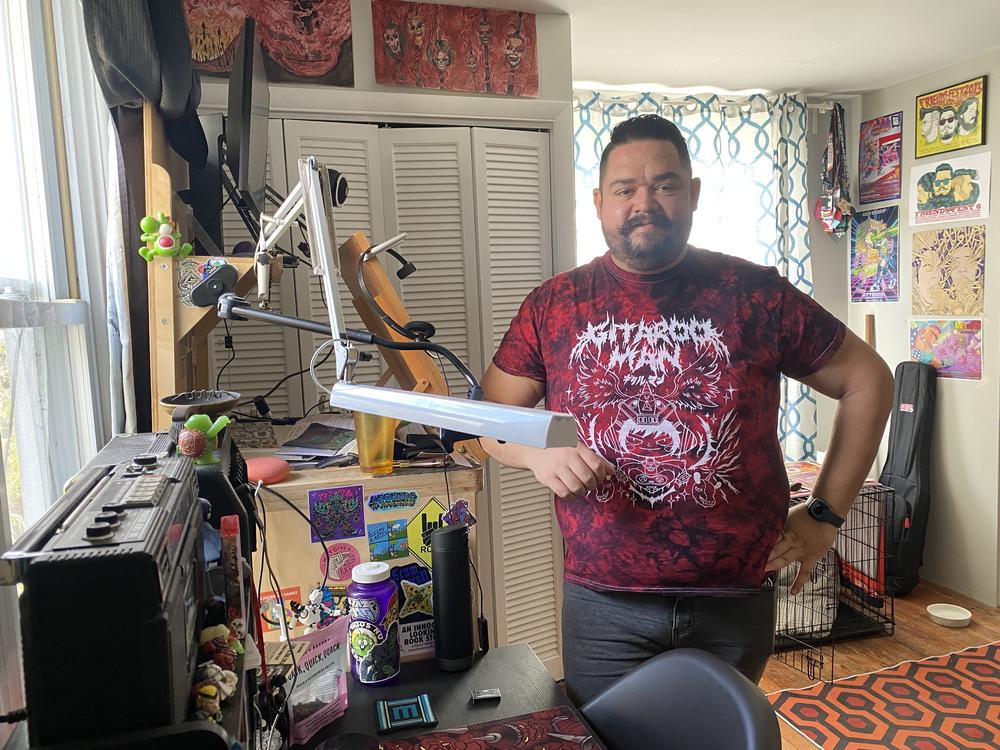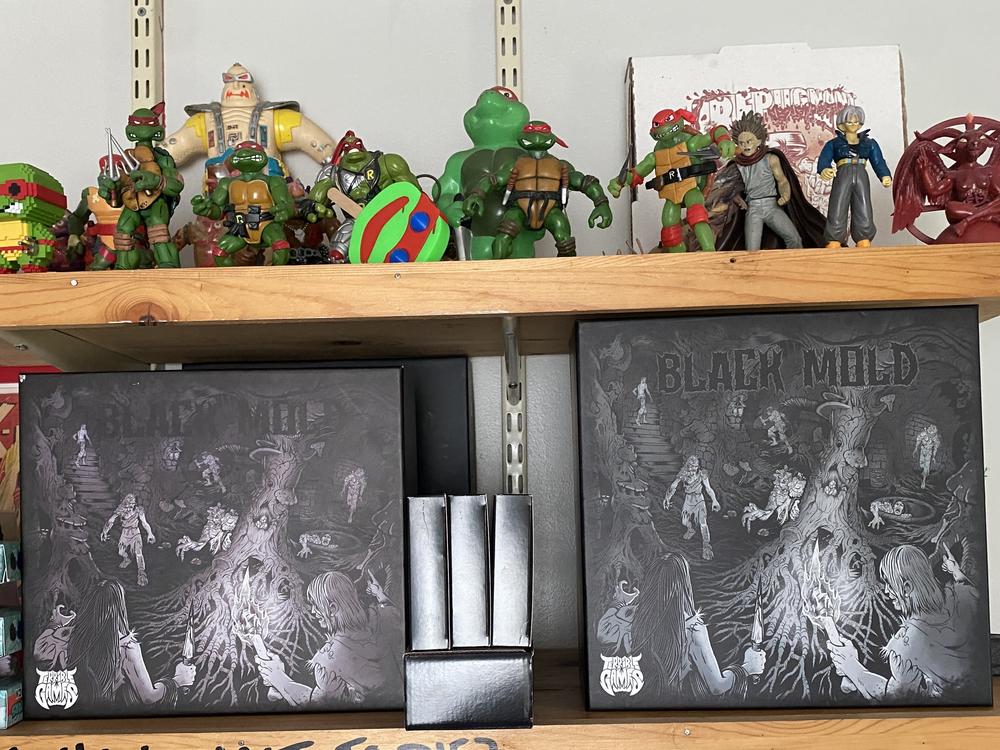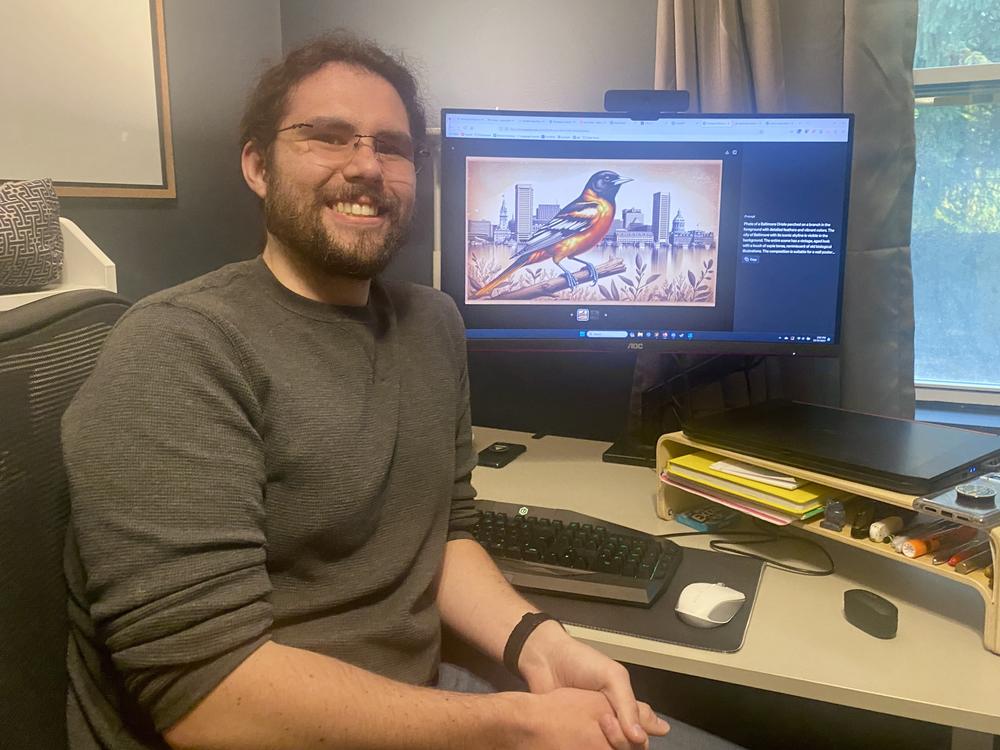Section Branding
Header Content
With ChatGPT turning 1, Americans wonder whether AI is coming for their jobs
Primary Content
Baltimore illustrator John de Campos was irate when he discovered that some of his original work had been used to train an artificial intelligence chatbot — without his permission.
"It's so gross," he says.
In just the past year, AI-powered programs like Midjourney and DALL-E have made it possible for anyone to create highly sophisticated images with just a few clicks of the keyboard.
For de Campos, that's an outrage.
"The fact that human expression and art is now at risk and on the chopping block is super duper scary to me," he says.
At the same time, de Campos, who aspires to make a living as a board game designer, has found ChatGPT to be a very effective helper when it comes to marketing his games on social media.
"I'll say, these are the qualities of the game that we're selling. Take all of this information, melt it down into 15 words or less. Give me five different versions written to sell this product on Instagram," he says.
De Campos acknowledges the hypocrisy that this presents and says he's trying to decide whether he should divorce himself from using any AI tool.
"I feel so strongly about the art side and not so much about the text side, but I'm kind of figuring it out," he says.
A year after the launch of ChatGPT, people in all kinds of occupations are figuring out where to draw the line with AI. Attitudes toward the new technology vary widely, with little consensus over which tasks can and should be handed over to bots.
The fastest writing assistant
In Michigan, Ethan Kissel has been turning to AI for help with his job producing television commercials for local businesses.
"It's really good for spitballing ideas," he says.
In the past, Kissel would spend an hour or more writing a 15- or 30-second script, with the hardest part being the tagline — the last, most memorable sentence. He discovered ChatGPT can deliver dozens of taglines in just a matter of seconds.
"Most of them are probably trash," he says. "But you take a bit from one and a couple words from another and fashion them all together, and suddenly you have something that you actually kind of like."
Kissel can easily can envision a future in which copywriters become dispensable, along with voice actors who do narration. His company already uses an AI tool to fix mispronunciations if they're short on time.
For now, though, Kissel is less worried about his own job. In addition to writing scripts, he also shoots and edits video and meets with clients. Being a jack-of-all-trades, he says, offers some protection.
"I don't think it's as scary of a problem for 'the right now.' But it is one that we need to discuss and plan for," he says.
Change is coming fast
Across professions, there are hints of what the future holds. Newspapers have used AI to write recaps of high school sports matches. Video game companies are using AI to create new characters. Software developers are using AI to write code.
Karin Kimbrough, chief economist for LinkedIn, which is owned by Microsoft, doesn't see AI coming for everyone's jobs right away. But she says AI will undoubtedly change how most people spend time on the job.
"You might spend less time on routine tasks," she says. "You might spend more time on things... that are really using your human-powered skills, your skills of empathy and ethical judgment, your skills of managing and leading people."
Ultimately, Kimbrough says, the hope is that AI will make people more efficient and productive.
But there are lots of pitfalls to avoid along the way. The internet is filled with stories of AI chatbots confidently delivering complete fabrications.
A New York lawyer was sanctioned this year after being caught citing bogus cases in a lawsuit against an airline. In court, he admitted he had used ChatGPT for legal research and hadn't bothered to double check the bot's work.
Such cases make it easy to see how irresponsible use of AI could end up harming people and society.
Learning the shortfalls and potential
Jeffrey Garcia, a program manager for a tech company, has taken it upon himself to figure out what AI is good at and what it's not, partly for fun but also to stay on top of developments that could shape his future employment.
His experimentation over the past year has given him a glimpse into the technology's shortfalls and potential.
As a child, Garcia was always frustrated with his inability to replicate on paper beautiful images conjured up in his mind.
"I have a deep love for art," he says. "But I suck at it."
This past spring, he wondered, could he open an Etsy store with a few products created with Midjourney? His first undertaking: a vintage-style poster of a favorite bird, the Baltimore oriole.
The program delivered a fairly sophisticated image of an oriole in front of a Baltimore skyline, but there were a few problems. Garcia's wife, a biologist, found extra toes on the bird's feet. The skyline did include a few recognizable landmarks but wouldn't hold up for anyone who knows the city.
Garcia didn't go on to sell any of his posters but concluded it would be fairly easy to commoditize such a product, especially given the rapid advancements AI image-generating tools have made. This fall, he tried using the newly-released DALL-E 3 to create the same poster and got a much-improved image, though still not free of anatomical errors.
"It's getting better, but still not good enough to pass the snuff of someone who knows what's going on," he says.
Experiments like this have informed how Garcia uses AI for work. He thinks of ChatGPT as a naïve assistant who can fairly effectively write first drafts, but whose work must be verified and edited.
And there are still some parts of his job that he's not ready to relinquish. Correspondence is one of them.
"I don't feel comfortable handing off this thing that I view as essential and deeply human to an automated system," he says.
Copyright 2023 NPR. To see more, visit https://www.npr.org.



